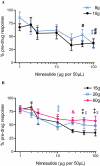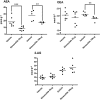Effects of COX-2 inhibition on spinal nociception: the role of endocannabinoids
- PMID: 20590570
- PMCID: PMC2931566
- DOI: 10.1111/j.1476-5381.2010.00703.x
Effects of COX-2 inhibition on spinal nociception: the role of endocannabinoids
Abstract
Background and purpose: Recent studies suggest that the effects of cyclooxygenase-2 (COX-2) inhibition are mediated by cannabinoid receptor activation. However, some non-steroidal anti-inflammatory drugs inhibit the enzyme fatty acid amide hydrolase, which regulates levels of some endocannabinoids. Whether COX-2 directly regulates levels of endocannabinoids in vivo is unclear. Here, the effect of the COX-2 inhibitor nimesulide, which does not inhibit fatty acid amide hydrolase, on spinal nociceptive processing was determined. Effects of nimesulide on tissue levels of endocannabinoids and related compounds were measured and the role of cannabinoid 1 (CB(1)) receptors was determined.
Experimental approach: Effects of spinal and peripheral administration of nimesulide (1-100 microg per 50 microL) on mechanically evoked responses of rat dorsal horn neurones were measured, and the contribution of the CB(1) receptor was determined with the antagonist AM251 (N-(piperidin-1-yl)-5-(-4-iodophenyl)-1-(2,4-dichlorophenyl)-4-methyl-1H-pyrazole-3-carboxamide), in anaesthetized rats. Effects of nimesulide on spinal levels of endocannabinoids and related compounds were quantified using liquid chromatography-tandem mass spectrometry.
Key results: Spinal, but not peripheral, injection of nimesulide (1-100 microg per 50 microL) significantly reduced mechanically evoked responses of dorsal horn neurones. Inhibitory effects of spinal nimesulide were blocked by the CB(1) receptor antagonist AM251 (1 microg per 50 microL), but spinal levels of endocannabinoids were not elevated. Indeed, both anandamide and N-oleoylethanolamide (OEA) were significantly decreased by nimesulide.
Conclusions and implications: Although the inhibitory effects of COX-2 blockade on spinal neuronal responses by nimesulide were dependent on CB(1) receptors, we did not detect a concomitant elevation in anandamide or 2-AG. Further understanding of the complexities of endocannabinoid catabolism by multiple enzymes is essential to understand their contribution to COX-2-mediated analgesia.
Figures





Similar articles
-
Endocannabinoid regulation of spinal nociceptive processing in a model of neuropathic pain.Eur J Neurosci. 2010 Apr;31(8):1414-22. doi: 10.1111/j.1460-9568.2010.07162.x. Epub 2010 Apr 9. Eur J Neurosci. 2010. PMID: 20384778
-
Inhibition of fatty acid amide hydrolase produces PPAR-alpha-mediated analgesia in a rat model of inflammatory pain.Br J Pharmacol. 2008 Dec;155(8):1297-306. doi: 10.1038/bjp.2008.335. Epub 2008 Aug 25. Br J Pharmacol. 2008. PMID: 18724387 Free PMC article.
-
Spinal endocannabinoids and CB1 receptors mediate C-fiber-induced heterosynaptic pain sensitization.Science. 2009 Aug 7;325(5941):760-4. doi: 10.1126/science.1171870. Science. 2009. PMID: 19661434 Free PMC article.
-
Endocannabinoid metabolism and uptake: novel targets for neuropathic and inflammatory pain.Br J Pharmacol. 2007 Nov;152(5):624-32. doi: 10.1038/sj.bjp.0707433. Epub 2007 Aug 20. Br J Pharmacol. 2007. PMID: 17704819 Free PMC article. Review.
-
Endocannabinoids in liver disease.Hepatology. 2011 Jan;53(1):346-55. doi: 10.1002/hep.24077. Hepatology. 2011. PMID: 21254182 Free PMC article. Review.
Cited by
-
Application of Metabolomics in Diagnosis of Cow Mastitis: A Review.Front Vet Sci. 2021 Oct 8;8:747519. doi: 10.3389/fvets.2021.747519. eCollection 2021. Front Vet Sci. 2021. PMID: 34692813 Free PMC article. Review.
-
Endocannabinoid involvement in endometriosis.Pain. 2010 Dec;151(3):703-710. doi: 10.1016/j.pain.2010.08.037. Epub 2010 Sep 15. Pain. 2010. PMID: 20833475 Free PMC article.
-
Non-opioid Analgesics and the Endocannabinoid System.Balkan Med J. 2020 Oct 23;37(6):309-315. doi: 10.4274/balkanmedj.galenos.2020.2020.6.66. Epub 2020 Jun 19. Balkan Med J. 2020. PMID: 32551466 Free PMC article.
-
Assessment of NSAIDs as potential inhibitors of the fatty acid amide hydrolase I (FAAH-1) using three different primary fatty acid amide substrates in vitro.BMC Pharmacol Toxicol. 2022 Jan 4;23(1):1. doi: 10.1186/s40360-021-00539-1. BMC Pharmacol Toxicol. 2022. PMID: 34983657 Free PMC article.
-
Substrate-selective COX-2 inhibition as a novel strategy for therapeutic endocannabinoid augmentation.Trends Pharmacol Sci. 2014 Jul;35(7):358-67. doi: 10.1016/j.tips.2014.04.006. Epub 2014 May 18. Trends Pharmacol Sci. 2014. PMID: 24845457 Free PMC article. Review.
References
-
- Bornheim LM, Kim KY, Chen B, Correia MA. The effect of cannabidiol on mouse hepatic microsomal cytochrome P450-dependent anandamide metabolism. Biochem Biophys Res Commun. 1993;197:740–746. - PubMed
-
- Chaplan SR, Bach FW, Pogrel JW, Chung JM, Yaksh TL. Quantitative assessment of tactile allodynia in the rat paw. J Neurosci Methods. 1994;53:55–63. - PubMed
Publication types
MeSH terms
Substances
Grants and funding
LinkOut - more resources
Full Text Sources
Medical
Research Materials

